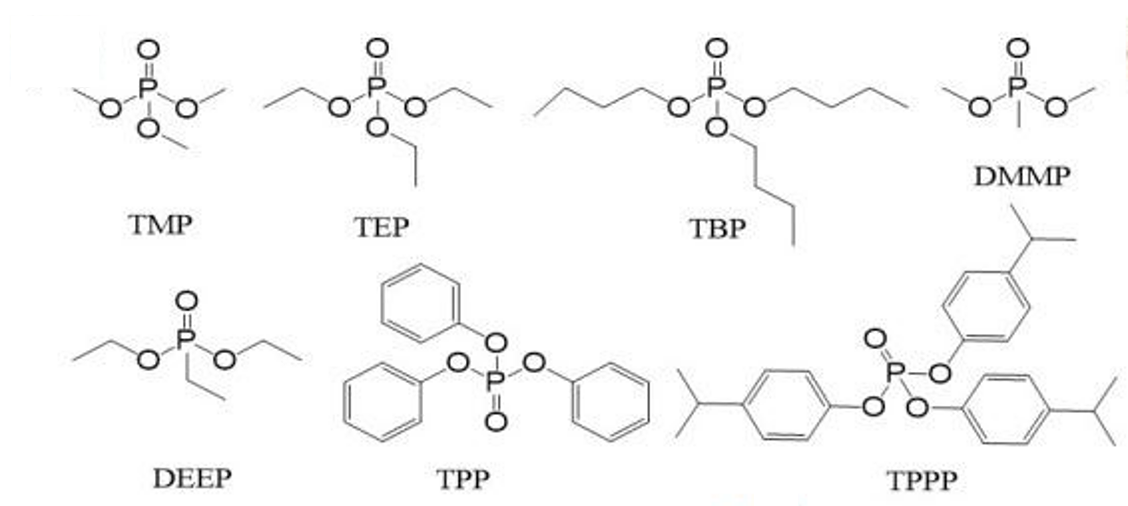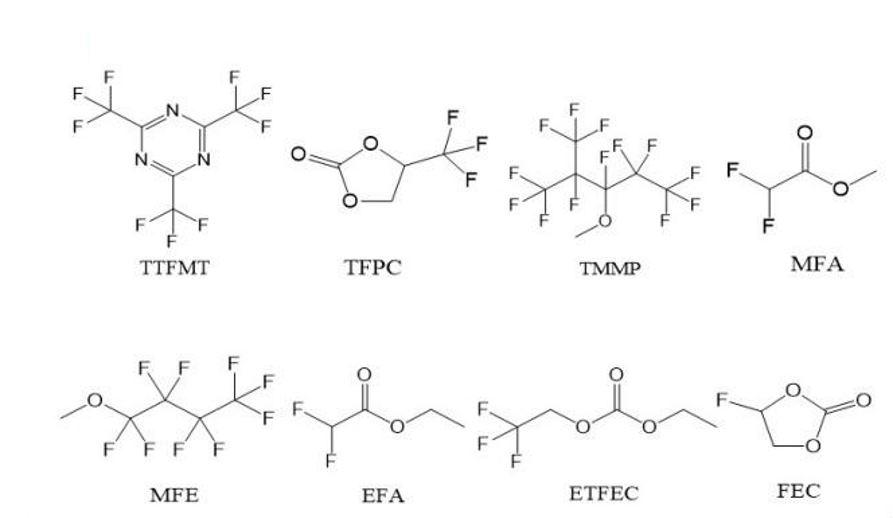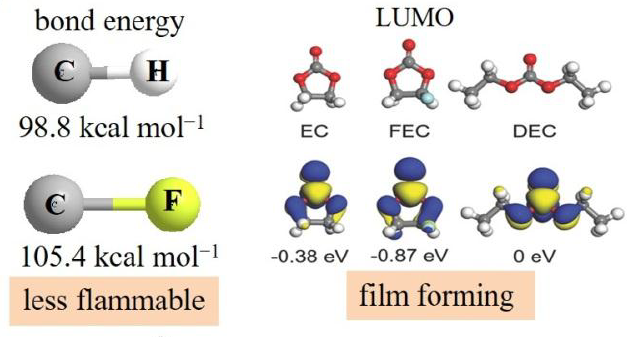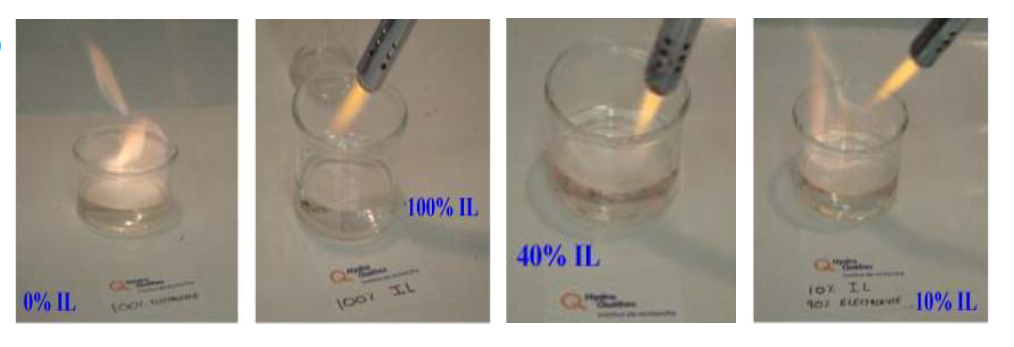如何提高锂离子电池中电解液的安全性?

引言
锂离子电池作为一种流行的储能设备,正被广泛应用于便携式电子设备、电动汽车、大型储能电站等动力领域[1-3]。随着能源结构的转变和大型电气设备的更新换代,锂离子电池无疑给人们的生活带来了巨大的变化和便利,但与此同时,其安全性问题始终存在。电解液作为锂离子电池中最易燃的成分,一直被认为与其安全性密切相关。电解液中主要易燃的成分是有机碳酸盐溶剂,仅靠提高锂盐的热稳定性是不够的。最直接的方法是在溶剂中加入阻燃剂或彻底放弃易燃溶剂。考虑到整个电解液体系的复杂性,较大的变化可能导致完整的电化学性能失效,初步研究主要集中在使用少量的阻燃添加剂。它们通常可以增加电解质的闪点,使其不那么易燃。本文讨论了电解液中各类阻燃剂的特点,作用机理以及研究进展,旨在为相关研究者提供新型电解液的设计思路。
磷阻燃添加剂
有机磷阻燃添加剂因其种类丰富、毒性低、物理相容性好、成本低等特点,在一开始就得到了广泛的研究[4]。用于锂离子电池电解质的常见磷阻燃剂包括磷酸三甲酯(TMP) [5]、磷酸三乙基(TEP) [6]、磷酸三丁酯(TBP) [7]、甲基膦二甲基酯(DMMP) [8, 9]、二乙基磷酸二乙酯(DEEP) [10]、磷酸三苯酯(TPP)[11]和4-异丙基磷酸苯基二苯酯(IPPP)[12](图1)。

图1:常见的几种磷阻燃添加剂的结构
总的来说,这些初步研究的磷阻燃剂的阻燃性能是值得肯定的,其较低的价格也是实际应用中一个很大的优势。但在有限用量的前提下,还是较难对整体电解质造成影响。它们的高粘度有导致电化学性能衰减的风险。磷阻燃添加剂的另一个常见问题是其电化学窗口不够宽,阳极表面经常会发生还原性分解反应,造成阻抗增加和容量退化[13]。有必要对这些磷酸盐进行进一步改性,以进一步提高阻燃性能,减少用量。
氟阻燃添加剂
由于具备高闪点和良好的热稳定性,卤素阻燃添加剂也常用于锂离子电池电解质。锂离子电池中使用的含卤素阻燃剂主要是有机氟化物(图2)。

图2:常见的几种氟阻燃添加剂的结构
与有机磷添加剂不同,有机氟添加剂的粘度较低,溶解度高,低温性能表现好[14]。因为C-F键的键能(105.4 kcal mol−1)比C-H键的键能(98.8 kcal mol−1)大,这就意味着破坏C-F键需要的能量越大,即有机氟添加剂具备更好的热稳定性(图3)。此外,通过氟原子取代氢原子,可以减少H·自由基,使得材料的易燃性大大降低[15]。因此,有机氟化物被认为是构建不可燃溶剂的最佳选择之一。Arai等以三氟碳酸丙烯(TFPC)为助溶剂合成了碳酸氯乙烯(ClEC) [16]。与PC/TFPC和EC/TFPC电解质相比,含有1 mol L-1 LiPF6的ClEC/TFPC二元电解质在石墨负极和Li1+xMn2O4负极材料上均表现出良好的循环性能。

图3:从键能和LUMO两方面阐释氟阻燃剂的不易燃成膜性能
对于高压锂离子电池,Xia等[17]报道了一种使用1,1,1,3,3,3-六氟异丙基甲基醚的不易燃电解质(HFPM)作为共溶剂,在4.9 V的高截止电压下,循环200次后仍能保持82%的容量。因此,与磷酸盐阻燃剂相比,氟化阻燃添加剂在维持电化学性能方面具有优势。这是因为这些有机氟添加剂的最低未占据分子轨道(LUMO)比电解质溶剂低[18]。在特有的氟原子电子效应影响下,有机氟添加剂可以提高电解液溶剂的还原电位,在阳极上形成更稳定的SEI膜(图3)。
氟阻燃剂通常表现出良好的电化学性能和阻燃效果,其低粘度有助于降低溶剂分子之间的吸引力,提高导电性。此外,氟元素可以改善SEI膜的组成和形貌,可以缓解使用高浓度电解质添加剂引起的容量衰减。但在大剂量的情况下,LiPF6与氟化阻燃剂的相容性普遍较差。因此,有必要探索合适的锂盐或对氟化阻燃剂进行改性,以提高其与LiPF6基电解质的兼容性。此外,目前氟化阻燃剂的成本仍然很高,需要特殊的设备和严格的制备工艺。
离子液体阻燃添加剂
离子液体作为一种不挥发、不易燃、无污染的液体,具有较宽的电化学窗口,近年来被合成并报道为电解质添加剂[19]。部分研究的锂离子电池电解质离子液体的化学结构如图4所示。

图4:常见的几种离子液体阻燃添加剂的结构
离子液体通常是指室温下完全由阴离子和阳离子组成的液态盐。因此,离子液体电解质有望取代传统的有机电解质,提高锂离子电池的安全性。良好的电化学性能的基础是保证合适的电导率和合适的电化学窗口。但是,离子液体的使用可能会受到限制,因为普通离子液体会在石墨阳极中分解,从而影响SEI膜的热稳定性。以具有良好的电化学性能和热稳定性的三氟甲基磺酰亚胺(TFSI)为基础,对其作为阴离子进行了深入研究。Guerfi等使用由1-乙基-3-甲基咪唑(EMI)和TFSI组成的离子液体与包括EC和DEC在内的商业电解质混合。得到的混合电解质具有与普通液体电解质相当的电化学性能[20]。当离子液体添加量为40%时,混合电解质不易燃(图5)。

图5:不同ECDEC-VC混合物与EMI-TFSI电解质的可燃性试验
Ishikawa报道了一种含有双氟磺酰亚胺(FSI)阴离子和EMI阳离子以及Nmethyl-的纯离子液体对n-丙基吡咯吡啶(P13)与石墨的相容性进行了详细的分析,对于半电池的测试结果,石墨阳极的可逆容量可以达到360 mAh g-1 [21]。
综上所述,离子液体作为一种新型的安全电解质,具备较高的热稳定性和低挥发性,具有良好的发展前景。但离子液体普遍存在的问题是高粘度导致室温下电导率低,且对纯度要求高,限制了合成工艺。另一个非常重要的方面是离子液体与传统电解质相比成本较高,这在很大程度上限制了目前的实际应用。因此,绝大多数的相关研究仍然是离子液体与传统有机电解质的结合。
复合阻燃添加剂
多年来,关于电解液阻燃添加剂的研究从未停止过,锂离子电池的阻燃添加剂种类繁多,但很少有添加剂能在少量添加的情况下显著提高阻燃效率的同时保证电化学性能。单一的阻燃剂往往需要较大的添加量,添加剂的溶解度和电解液的兼容性都非常有限。因此,有必要通过综合各种类型的阻燃剂的优点和缺点来配置更适合锂离子电池的添加剂[22]。复合添加剂的引入有利于减少添加剂的用量,提高阻燃效率。并且几种阻燃元素可以起到协同作用[23],甚至在提高热稳定性的同时提高循环性能。目前研究的复合阻燃电解质添加剂主要有磷-氮化合物[24]和磷-氟化合物[23]。
氟化磷酸盐是典型的F-P复合添加剂。烷基磷酸盐的氟化是降低粘度和氟化程度最有效的方法之一,氟化基团的位置和类型对阻燃剂和电化学性能有显著不同的影响。Shiga等发现,通过烷基氟化,TFEP及其与带电电极的混合物的热稳定性可以比TMP等未氟化的磷酸盐有所提高[25]。Zhu等使用二乙基膦酸酯、二甲基甲酰胺、三氟乙醇和三甲胺进行合成TFEP化合物作为电解质阻燃添加剂。普通碳酸盐电解质在TFEP用量为20%时可完全不燃[26]。
参考文献
[1] Armand M, Tarascon J M. Building better batteries[J]. nature, 2008, 451(7179): 652-657.https://www.nature.com/articles/451652a
[2] Goodenough J B, Kim Y. Challenges for rechargeable Li batteries[J]. Chemistry of materials, 2010, 22(3): 587-603.https://doi.org/10.1021/cm901452z
[3] Nitta N, Wu F, Lee J T, et al. Li-ion battery materials: present and future[J]. Materials today, 2015, 18(5): 252-264.https://doi.org/10.1016/j.mattod.2014.10.040
[4] Green J. A review of phosphorus-containing flame retardants[J]. Journal of fire sciences, 1992, 10(6): 470-487.https://doi.org/10.1177/073490419201000602
[5] Yao X L, Xie S, Chen C H, et al. Comparative study of trimethyl phosphite and trimethyl phosphate as electrolyte additives in lithium-ion batteries[J]. Journal of power sources, 2005, 144(1): 170-175.https://doi.org/10.1016/j.jpowsour.2004.11.042
[6] Wang X, Yasukawa E, Kasuya S. Nonflammable trimethyl phosphate solvent-containing electrolytes for lithium-ion batteries: I. Fundamental properties[J]. Journal of The Electrochemical Society, 2001, 148(10): A1058.https://iopscience.iop.org/article/10.1149/1.1397773/meta
[7] Hyung Y E, Vissers D R, Amine K. Flame-retardant additives for lithium-ion batteries[J]. Journal of power sources, 2003, 119: 383-387. https://doi.org/10.1016/S0378-7753(03)00225-8
[8] Xiang H F, Xu H Y, Wang Z Z, et al. Dimethyl methylphosphonate (DMMP) as an efficient flame retardant additive for the lithium-ion battery electrolytes[J]. Journal of Power Sources, 2007, 173(1): 562-564.https://doi.org/10.1016/j.jpowsour.2007.05.001
[9] Zeng Z, Wu B, Xiao L, et al. Safer lithium-ion batteries based on nonflammable electrolyte[J]. Journal of Power Sources, 2015, 279: 6-12.https://doi.org/10.1016/j.jpowsour.2014.12.150
[10] Feng J, Ma P, Yang H, et al. Understanding the interactions of phosphonate-based flame-retarding additives with graphitic anode for lithium-ion batteries[J]. Electrochimica Acta, 2013, 114: 688-692.https://doi.org/10.1016/j.electacta.2013.10.104
[11] Högström K C, Lundgren H, Wilken S, et al. Impact of the flame retardant additive triphenyl phosphate (TPP) on the performance of graphite/LiFePO4 cells in high power applications[J]. Journal of Power Sources, 2014, 256: 430-439.https://doi.org/10.1016/j.jpowsour.2014.01.022
[12] Wang Q, Sun J, Yao X, et al. 4-Isopropyl phenyl diphenyl phosphate as flame-retardant additive for lithium-ion battery electrolyte[J]. Electrochemical and Solid-State Letters, 2005, 8(9): A467.
https://iopscience.iop.org/article/10.1149/1.1993389/meta
[13] Xu K, Ding M S, Zhang S, et al. An attempt to formulate nonflammable lithium-ion electrolytes with alkyl phosphates and phosphazenes[J]. Journal of the Electrochemical Society, 2002, 149(5): A622.https://iopscience.iop.org/article/10.1149/1.1467946/meta
[14] Chandrasekaran R, Koh M, Ozhawa Y, et al. Electrochemical cell studies on fluorinated natural graphite in propylene carbonate electrolyte with difluoromethyl acetate (MFA) additive for low temperature lithium battery application[J]. Journal of chemical sciences, 2009, 121: 339-346.https://link.springer.com/article/10.1007/s12039-009-0039-2
[15] Nagasubramanian G, Fenton K. Reducing Li-ion safety hazards through use of non-flammable solvents and recent work at Sandia National Laboratories[J]. Electrochimica Acta, 2013, 101: 3-10.https://doi.org/10.1016/j.electacta.2012.09.065
[16] Arai J, Katayama H, Akahoshi H. Binary mixed solvent electrolytes containing trifluoropropylene carbonate for lithium secondary batteries[J]. Journal of the Electrochemical Society, 2002, 149(2): A217.https://iopscience.iop.org/article/10.1149/1.1433749/meta
[17] Xia L, Xia Y, Wang C, et al. 5 V‐class electrolytes based on fluorinated solvents for Li‐ion batteries with excellent cyclability[J]. ChemElectroChem, 2015, 2(11): 1707-1712.https://doi.org/10.1002/celc.201500286
[18] Zhang Z, Hu L, Wu H, et al. Fluorinated electrolytes for 5 V lithium-ion battery chemistry[J]. Energy & Environmental Science, 2013, 6(6): 1806-1810.https://doi.org/10.1039/C3EE24414H
[19] Lewandowski A, Świderska-Mocek A. Ionic liquids as electrolytes for Li-ion batteries—An overview of electrochemical studies[J]. Journal of Power sources, 2009, 194(2): 601-609.https://doi.org/10.1016/j.jpowsour.2009.06.089
[20] Guerfi A, Dontigny M, Charest P, et al. Improved electrolytes for Li-ion batteries: Mixtures of ionic liquid and organic electrolyte with enhanced safety and electrochemical performance[J]. Journal of Power Sources, 2010, 195(3): 845-852.https://doi.org/10.1016/j.jpowsour.2009.08.056
[21] Ishikawa M, Sugimoto T, Kikuta M, et al. Pure ionic liquid electrolytes compatible with a graphitized carbon negative electrode in rechargeable lithium-ion batteries[J]. Journal of power sources, 2006, 162(1): 658-662.https://doi.org/10.1016/j.jpowsour.2006.02.077
[22] Wilhelm H A, Marino C, Darwiche A, et al. Significant electrochemical performance improvement of TiSnSb as anode material for Li-ion batteries with composite electrode formulation and the use of VC and FEC electrolyte additives[J]. Electrochemistry communications, 2012, 24: 89-92.https://doi.org/10.1016/j.elecom.2012.08.023
[23] Zeng Z, Jiang X, Wu B, et al. Bis (2, 2, 2-trifluoroethyl) methylphosphonate: an novel flame-retardant additive for safe lithium-ion battery[J]. Electrochimica Acta, 2014, 129: 300-304.https://doi.org/10.1016/j.electacta.2014.02.062
[24] Izquierdo-Gonzales S, Li W, Lucht B L. Hexamethyl phosphoramide as a flame retarding additive for lithium-ion battery electrolytes[J]. Journal of power sources, 2004, 135(1-2): 291-296.https://doi.org/10.1016/j.jpowsour.2004.04.011
[25] Shiga T, Kato Y, Kondo H, et al. Self-extinguishing electrolytes using fluorinated alkyl phosphates for lithium batteries[J]. Journal of Materials Chemistry A, 2017, 5(10): 5156-5162.https://doi.org/10.1039/C6TA09915G
[26] Zhu X, Jiang X, Ai X, et al. Bis (2, 2, 2-Trifluoroethyl) ethylphosphonate as novel high-efficient flame retardant additive for safer lithium-ion battery[J]. Electrochimica Acta, 2015, 165: 67-71.
https://doi.org/10.1016/j.electacta.2015.02.247





